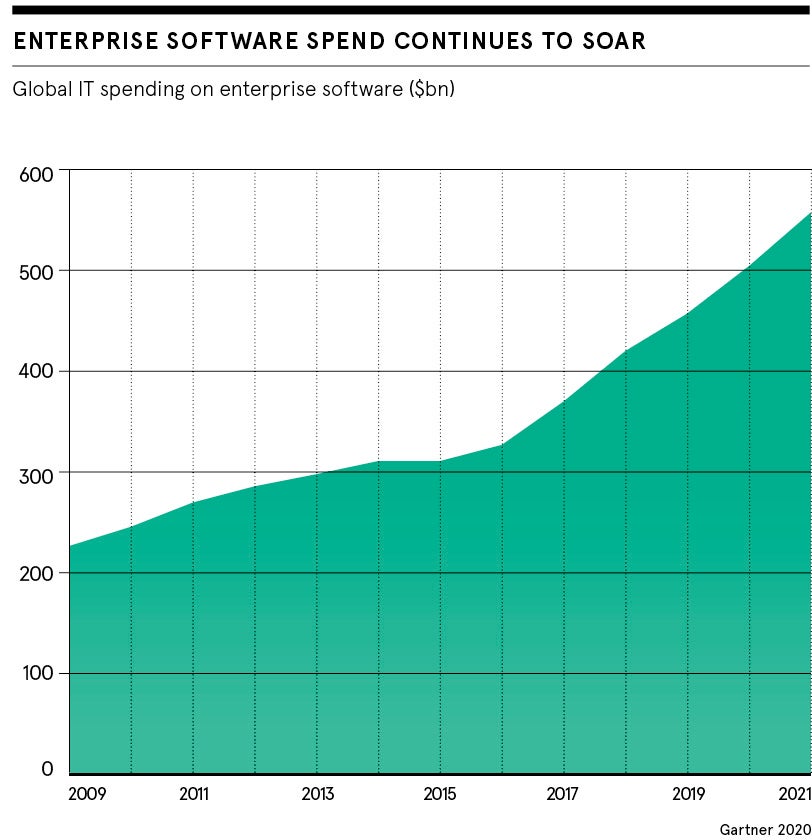Once seen as a way to cut down on endless meetings and give us better control of our time, email is now looking a little antiquated in the workplace.
From project management tools that can plan our day by the minute to instant messaging platforms connecting colleagues across departments in seconds, enterprise software has offered businesses a far more sophisticated, agile and efficient means of communication.
But if businesses are looking for a fundamental way to improve employee engagement and people’s working lives, there’s no guarantee enterprise software will provide the answer.
The world is becoming increasingly dominated by social media and technology that gives instant access, but is this what employees want in their working lives? Or is employee enterprise software just another distraction from creating good work?
A new dawn for employee enterprise software
As many thousands of workers move away from their office to work from home during the coronavirus crisis, more than ever we need tools that help us communicate with our colleagues quickly, efficiently and sensitively.
A report from Gartner, Coronavirus (COVID-19) outbreak: long and short-term actions for CIOs, highlights just how vital enterprise software has become. One of the company’s recommendations is that employers must expand its digital workplaces and access. Identifying potential risks to security, updating policies and access training, and providing new technological capabilities, such as video calls, messaging and collaboration tools, all play a role.
“This really should be a wake-up call for organisations that spend too much time focusing on daily operational needs at the expense of investing in digital business and long-term resilience,” says Sandy Shen, senior digital analyst at Gartner.
“There’s also an opportunity for CIOs [chief information officers] to get to the top of the table with this, through working closely with human resources. You need to come up with a technology-enabled business plan. In these situations, WhatsApp and Facebook Work and other platforms can be helpful, but you have to take every step to ensure it’s secure and used properly.”

Are they actually making people more productive?
Long before the rates of home-working skyrocketed, there were already many clear, profitable benefits to introducing this kind of tech.
The theory behind the use of Slack and other enterprise software is similar to that of an open-plan office. It is designed to make communication far more open, to erode hierarchies and give teams a better sense of connection. Putting this into practice, however, isn’t so simple.
For example, RescueTime, which provides time management advice and tools, noted that out of the ten hours employees spend sitting at their screens each day, half of those are on chat messaging apps like Slack, Teams and Workplace. Notably, it also found that employees had not spent less time communicating with each other than they had done six years ago.
“The aim of these apps should be that people are spending less time on communicating, but if we look at the impact these tools are having, it can be a lot less impressive than we’d like. We need to think really critically about how we use these tools,” says Robby McDonnell, chief executive at RescueTime.
There’s also the issue of constant messaging breaking up flow or focus. Getting 45 to 50 messages a day can make it much harder to get the intense periods of focus employees want.
This really should be a wake-up call for organisations that spend too much time focusing on daily operational needs at the expense of investing in digital business and long-term resilience
On average, information workers spend three minutes on any single task before being interrupted or switching to another, according to a Microsoft study shared with Recode, which used wearable sensors and computer-tracking software. Multitaskers can experience a 40 per cent decrease in productivity, according to Microsoft.
This kind of multitasking means there’s a risk that instead of doing one thing well, you could actually just be switching between activities and doing them all poorly. As McDonnell sums up: “Just because you have a lot more of something, or it’s a lot faster, doesn’t necessarily make it better.”
Avoiding social media communication pitfalls
As well as avoiding an influx of communication through enterprise software, businesses might need to look at exactly how they monitor its use.
It’s often said that businesses should focus on technology and the workplace experience through looking at consumers. As people would expect instant streaming services for entertainment and a quick way to connect with family and friends, it’s not unreasonable to expect the same experience at work.
But the Economist Intelligence Unit found these sorts of systems can lead to discrepancies and occasional upset in workplace communication as some 31 per cent of millennials use instant messaging to communicate with colleagues and clients, compared to just 12 per cent of employees over the age of 55, for example.
The research suggests this can have serious implications for workplaces as poor communications can lead to stressful work environments, stalled careers, missed performance goals and lost sales.
But Adrian Furnham, principal behavioural psychologist at Stamford Associates, says these fears might be exaggerated: “For so many, instant messaging has become the primary way of communicating; think about how many people would rather get in touch via a text than a phone call?
“There’s perhaps a risk that older people might struggle, but even they’re catching on a lot more quickly to technology with some encouragement.”
Better internal communication should be more about carefully communicated targets and feedback. Furnham concludes: “The best thing to focus on will always be outcomes. It’s best just to make clear what needs to get done and explain if there’s a problem. How you get there doesn’t matter.”
A new dawn for employee enterprise software

